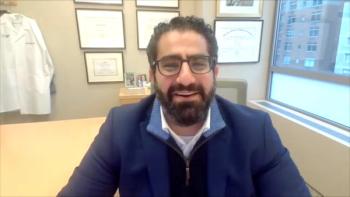
The American Journal of Managed Care
- May 2022
- Volume 28
- Issue 5
Patterns of Opioid Use in Commercially Insured Patients With Cancer
Among the fewer than half of patients with cancer who received opioid fills, a relatively small proportion (2.5%) had potentially problematic opioid use.
ABSTRACT
Objectives: In an era of heightened opioid prescribing scrutiny, ensuring safe and adequate pain management is challenging. Understanding opioid use in patients with cancer can facilitate effective pain management regimens while minimizing safety concerns. This study characterized patterns of and factors associated with opioid use following a new cancer diagnosis.
Study Design: Retrospective cohort study.
Methods: Our study included patients with a new cancer diagnosis aged 18 to 64 years in IQVIA PharMetrics Plus 2007-2013 who were continuously enrolled 12 months before receiving their cancer diagnosis and 24 months after. Study outcomes included opioid prevalence and measures of potentially high-risk opioid use (total days supplied, number of prescriptions, and morphine equivalent daily dose [MEDD]). Descriptive analyses and logistic regression were implemented.
Results: Of 191,616 eligible individuals, 93,739 (48.9%) received opioid prescriptions; of these, 56,025 (59.8%) were new opioid users. Opioid users received 4.6 prescriptions on average, covering 65 total days with a mean MEDD of 31.8 mg. Only 2387 (2.5%) patients received higher than recommended (≥ 90 mg) MEDD. Predictors of opioid use post cancer included prior opioid use, select comorbidities, use of nonopioid pain treatment adjuvants (muscle relaxants, sedative/hypnotics, anticonvulsants, antidepressants, and steroids), cancer site, and metastatic cancer.
Conclusions: Fewer than half of patients received opioids in the 2 years following cancer onset. Among users, we found a relatively small proportion of potentially problematic opioid use. Further research is warranted to assess the adequacy of cancer pain treatment and determinants of high-risk opioid use.
Am J Manag Care. 2022;28(5):207-211.
Takeaway Points
- Published evidence on prevalent and new use of opioids in commercially insured patients with cancer remains limited.
- This research found that almost half (48.9%) of 191,616 commercially insured patients with a new cancer diagnosis received opioid prescriptions, and about 60% were new opioid users.
- A small percentage (2.5%) of opioid users had a high morphine equivalent daily dose (≥ 90 mg).
- The strongest baseline predictors of opioid prescriptions following cancer diagnosis were prior opioid use, nonopioid pain treatment adjuvant use, cancer sites, metastatic cancer, and select comorbidities.
Policies addressing the US opioid crisis have been linked to reduced opioid use and overdose in the general population.1 Studies have focused on problematic opioid use in individuals with chronic noncancer pain or prior substance use history and in other at-risk populations.1-3 Less is known about how the current opioid prescribing environment affects the use of opioids for appropriate pain treatment among patients with cancer.4
Balancing safe opioid use with sufficient pain relief continues to challenge patients with cancer and their care providers. Inadequate pain management influences health outcomes and quality of life in patients with cancer.5 More than half of these patients experience pain,6 and the likelihood of experiencing pain increases with cancer survival.7 The American Society of Clinical Oncology and American Cancer Society emphasize that most patients with cancer will require opioids during their treatment.8,9
Characterization of opioid use within evolving policy environments is a critical first step to understanding pain treatment for patients with cancer, yet current evidence is both limited and inconsistent with regard to opioid dose, duration, and predictors of utilization. Several studies have reported on opioid dose and duration in patients with cancer,10-12 with one study of Medicaid patients demonstrating that patients with cancer received more opioids than patients without cancer.12 In a study using the National Survey on Drug Use and Health, a higher rate of opioid use but a similar rate of opioid use disorder was observed among more recent cancer survivors compared with less recent cancer survivors and patients without cancer.13 Among commercially insured patients, cancer pain expression was not associated with increased opioid dose or duration compared with patients with noncancer chronic pain.10 These patients with cancer pain received lower mean (SD) total opioid days supplied than those with noncancer chronic pain (166.8 [340.3] and 190.1 [422.0] days, respectively).10 Finally, a study at a large cancer center reported a reduction in median morphine equivalent daily dose (MEDD) at the time of referral to outpatient palliative care from 78 mg to 40 mg over a 6-year period.11
Other limited research on factors influencing opioid receipt in patients with cancer corroborates those factors observed in populations without cancer, including age, race, sex, nonopioid pain treatment adjuvant use, and select comorbidities (eg, substance use disorder, psychiatric disorders, pain-related conditions).14-16 Despite known associations between pain intensity and advanced cancer staging,17 only 1 study incorporated cancer site in observational studies to predict long-term opioid use.16 This study characterized patterns of and factors associated with opioid use in commercially insured patients with newly diagnosed cancer.
METHODS
Study Design and Cohort
This retrospective cohort study included newly diagnosed cancer (excluding benign neoplasms, carcinoma in situ, and nonmelanoma skin cancer) in patients aged 18 to 64 years in IQVIAPharMetrics Plus data between January 1, 2007, and December 31, 2013, which represented at least 70% of patients with cancer younger than 65 years in the United States.18 The index date was date of first cancer diagnosis after a 1-year washout, with continuous enrollment in medical and prescription plans for 12 months before receiving their cancer diagnosis and 24 months after.
Main Outcomes
Opioid use was estimated in the 24 months following cancer diagnosis with measures commonly used in claims analyses1: (1) any opioid use, and (2) among opioid users, total days supplied (intermittent use), number of prescriptions, and MEDD (quantity supplied × conversion factor / total days supplied). High-risk opioid use was assessed using MEDDs of 50 mg or greater, 90 mg or greater, and 120 mg or greater.19
Baseline Predictors
Baseline covariates, selected based on prior literature,1,17,19 were measured 12 months preindex. These included opioid receipt; nonopioid pain treatment adjuvant use (muscle relaxants, sedative/hypnotics, anticonvulsants, antidepressants, and steroids); cancer site by International Classification of Diseases, Ninth Revision, Clinical Modification (ICD-9-CM) codes; metastasis of cancer (ICD-9-CM codes 196.xx-198.xx)20; age; sex; region; and comorbidities.
Statistical Analyses
Frequency (percentage) and mean (SD) are used to describe baseline characteristics and patterns of opioid use. Multivariable logistic regression identified factors associated with opioid receipt post cancer diagnosis. The final model was selected based on factors’ statistical significance (95% CIs) and C statistics. The University of Maryland Baltimore Institutional Review Board approved this study as an exempt protocol.
RESULTS
Among 191,616 eligible patients with cancer, 93,739 (48.9%) received opioids post index; of these, 56,025 (59.6%) were new users.
Opioid users were more likely to be older, female, and in the South. Compared with nonusers, opioid users had significantly higher baseline comorbidities, pain treatment adjuvant use, and metastasis of cancer (
During follow-up, opioid users received, on average, 4.6 opioid prescriptions, 65 total days supplied, and a MEDD of 31.8 mg. One in 10 patients (10.3%) exceeded a MEDD of 50 mg and 2387 (2.5%) exceeded a MEDD of 90 mg; only 834 (0.9%) exceeded a MEDD of 120 mg. Among opioid users, 11,103 (11.8%) received at least 90 days’ supply; 7473 (7.9%) received at least 180 days (
Baseline predictors of opioid use included baseline opioid use (odds ratio [OR], 2.46; 95% CI, 2.40-2.51), muscle relaxant use (OR, 1.64; 95% CI, 1.57-1.71), metastatic cancer (OR, 2.47; 95% CI, 2.07-2.96), and select cancer sites (breast [OR, 2.0; 95% CI, 1.75-2.29]; gynecological [OR, 1.77; 95% CI, 1.54-2.04]; and head and neck [OR, 1.51; 95% CI, 1.32-1.71]). Pain-related comorbidities associated with increased opioid use included asthma, chronic obstructive pulmonary disease, arthritis, chronic pain, chronic kidney disease, liver diseases, and smoking disorder. Psychiatric disorders, osteoporosis, and bone and soft tissue cancers predicted lower opioid use (Table 3 [
DISCUSSION
To the best of our knowledge, this is one of the few large observational studies reporting opioid use following new cancer diagnosis. Our findings indicate that cancer site and progression are among the strongest predictors of opioid receipt in addition to predictors observed in noncancer populations (eg, age, sex, prior opioid use, nonopioid pain treatment adjuvant use, pain-related comorbidities). This is similar to prior literature from Barbera et al, who found that prior and continuous opioid use were the strongest predictors of opioid use 5 years post cancer survivorship.16 We focus on the assessment of long-term opioid utilization and overuse (24 months) because these measures are predictors of increased opioid-related adverse effects.21 Our findings also echo those of Barbera et al in that relatively few patients with cancer use opioids long term and that cancer site is a strong predictor of these outcomes.16
We found a small proportion (2.5%) of patients with cancer with excessive opioid use in the 2 years post cancer diagnosis. Our finding that fewer than 3 in 100 opioid users had a MEDD of at least 90 mg indicates that overprescribing may not be a considerable concern in this population. In our study, number of opioid prescriptions, total days supplied, and MEDD were lower than findings in another study using commercial claims data,10 an inconsistency possibly due to differences in study design, follow-up time, and sociodemographics (eg, age, sex, geography). Also, opioid use in our study (49%) is slightly lower than the prevalence of pain in patients with cancer in a pooled analysis of global studies including all cancer sites and progression severity (53%; 95% CI, 43%-63%).6 Combined with findings of a small proportion of patients with high opioid dose and duration, our results warrant further investigation of the potential undertreatment of pain and the determinants of high-risk opioid use among patients with cancer.
Previous literature has demonstrated reductions of opioid prescriptions and overdoses in general and noncancer pain populations associated with rigorous opioid prescribing policies.1 There is considerable focus on reducing opioid utilization among younger adults, those with substance use histories, and other populations perceived to be most at risk of experiencing adverse events or those without a clinical need.1 Despite real or perceived exemption for patients with cancer from many opioid reduction policies, including the CDC opioid prescribing guidelines, patients with cancer are likely affected by unintended spillover effects of these initiatives,4 which may limit opioid access and lead to subsequent pain undertreatment. Also, policies that restrict opioid prescriptions may increase illicit drug use, especially among high-risk users. Examining specific effects of opioid policies on patients with cancer is beyond the scope of this study but warrants further investigation. Results indicate the need for individualized assessment and treatment of pain with opioids for patients with cancer in clinical practice, a challenging goal given the heightened prescribing scrutiny prompted by the opioid epidemic.
Limitations
Our findings are generalizable to patients who survive at least 24 months following cancer diagnosis. Claims data lack individualized report of pain and critical variables for use in risk factor models such as cancer stage, which makes assessment of pain management adequacy difficult. We accounted for advanced disease using ICD-9-CM codes for metastatic cancer.
CONCLUSIONS
Our study found that 49% of patients with new cancer used opioids during a 2-year follow-up period, with only 2.5% exceeding potentially problematic dosage levels. Opioid use was associated with prior opioid use, nonopioid pain treatment adjuvant use, cancer sites, metastatic cancer, and select comorbidities. Current policies to reduce inappropriate opioid prescribing may unintentionally affect pain management or increase illicit drug use in patients with cancer. Future research is needed to assess pain treatment adequacy, congruence with current opioid prescribing guidelines, and impacts of opioid policies on patient-centered cancer pain treatment.
Author Affiliations: Department of Pharmaceutical Health Services Research (TTL, SPF, LS-W) and Peter Lamy Center on Drug Therapy and Aging (TTL, SPF, LS-W), University of Maryland Baltimore, Baltimore, MD.
Source of Funding: None.
Author Disclosures: The authors report no relationship or financial interest with any entity that would pose a conflict of interest with the subject matter of this article.
Authorship Information: Concept and design (TTL, SPF, LS-W); acquisition of data (SPF, LS-W); analysis and interpretation of data (TTL, SPF, LS-W); drafting of the manuscript (TTL, SPF, LS-W); critical revision of the manuscript for important intellectual content (TTL, SPF, LS-W); provision of patients or study materials (TTL); administrative, technical, or logistic support (TTL, SPF); and supervision (TTL, LS-W).
Address Correspondence to: Linda Simoni-Wastila, PhD, MSPH, University of Maryland Baltimore, 220 Arch St, 12th Fl, Baltimore, MD 21201. Email: lsimoniw@rx.umaryland.edu.
REFERENCES
1. Rhodes E, Wilson M, Robinson A, Hayden JA, Asbridge M. The effectiveness of prescription drug monitoring programs at reducing opioid-related harms and consequences: a systematic review. BMC Health Serv Res. 2019;19(1):784. doi:10.1186/s12913-019-4642-8
2. Chui PW, Bastian LA, DeRycke E, Brandt CA, Becker WC, Goulet JL. Dual use of Department of Veterans Affairs and Medicare benefits on high-risk opioid prescriptions in veterans aged 65 years and older: insights from the VA Musculoskeletal Disorders Cohort. Health Serv Res. 2018;53(suppl 3):5402-5418. doi:10.1111/1475-6773.13060
3. Raman SR, Bush C, Karmali RN, Greenblatt LH, Roberts AW, Skinner AC. Characteristics of new opioid use among Medicare beneficiaries: identifying high-risk patterns. J Manag Care Spec Pharm. 2019;25(9):966-972. doi:10.18553/jmcp.2019.25.9.966
4. Graetz I, Yarbrough CR, Hu X, Howard DH. Association of mandatory-access prescription drug monitoring programs with opioid prescriptions among Medicare patients treated by a medical or hematologic oncologist. JAMA Oncol. 2020;6(7):1102-1103. doi:10.1001/jamaoncol.2020.0804
5. Mantyh PW. Cancer pain and its impact on diagnosis, survival and quality of life. Nat Rev Neurosci. 2006;7(10):797-809. doi:10.1038/nrn1914
6. van den Beuken-van Everdingen MHJ, de Rijke JM, Kessels AG, Schouten HC, van Kleef M, Patijn J. Prevalence of pain in patients with cancer: a systematic review of the past 40 years. Ann Oncol. 2007;18(9):1437-1449. doi:10.1093/annonc/mdm056
7. Sanford NN, Sher DJ, Butler SS, et al. Prevalence of chronic pain among cancer survivors in the United States, 2010-2017. Cancer. 2019;125(23):4310-4318. doi:10.1002/cncr.32450
8. Bruera E, Del Fabbro E. Pain management in the era of the opioid crisis. Am Soc Clin Oncol Educ Book. 2018;38:807-812. doi:10.1200/EDBK_208563
9. American Cancer Society Cancer Action Network comments on CDC draft opioid prescribing guidelines. American Cancer Society Cancer Action Network. October 1, 2015. Accessed September 1, 2020. https://www.fightcancer.org/sites/default/files/ACSCAN_Comments_CDC_Opioid_Guidelines_Final.pdf
10. Datto CJ, Hu Y, Wittbrodt E, Fine PG. Opioid utilization patterns among patients with cancer and non-cancer pain. J Opioid Manag. 2019;15(1):11-18. doi:10.5055/jom.2019.0481
11. Haider A, Zhukovsky DS, Meng YC, et al. Opioid prescription trends among patients with cancer referred to outpatient palliative care over a 6-year period. J Oncol Pract. 2017;13(12):e972-e981. doi:10.1200/JOP.2017.024901
12. Moyo P, Gellad WF, Sabik LM, et al. Opioid prescribing safety measures in Medicaid enrollees with and without cancer. Am J Prev Med. 2019;57(4):540-544. doi:10.1016/j.amepre.2019.05.019
13. Jairam V, Yang DX, Verma V, Yu JB, Park HS. National patterns in prescription opioid use and misuse among cancer survivors in the United States. JAMA Netw Open. 2020;3(8):e2013605. doi:10.1001/jamanetworkopen.2020.13605
14. Brescia AA, Harrington CA, Mazurek AA, et al. Factors associated with new persistent opioid usage after lung resection. Ann Thorac Surg. 2019;107(2):363-368. doi:10.1016/j.athoracsur.2018.08.057
15. Saraswathula A, Chen MM, Mudumbai SC, Whittemore AS, Divi V. Persistent postoperative opioid use in older head and neck cancer patients. Otolaryngol Head Neck Surg. 2019;160(3):380-387. doi:10.1177/0194599818778276
16. Barbera L, Sutradhar R, Howell D, et al. Factors associated with opioid use in long-term cancer survivors. J Pain Symptom Manage. 2019;58(1):100-107.e2. doi:10.1016/j.jpainsymman.2019.02.024
17. Vitzthum L, Riviere P, Sheridan P, et al. Predicting persistent opioid use, abuse and toxicity among cancer survivors. J Natl Cancer Inst. 2020;112(7):720-727. doi:10.1093/jnci/djz200
18. Tran Q, Warren JL, Barrett MJ, et al. An evaluation of the utility of big data to supplement cancer treatment information: linkage between IQVIA pharmacy database and the Surveillance, Epidemiology, and End Results Program. J Natl Cancer Inst Monogr. 2020;2020(55):72-81. doi:10.1093/jncimonographs/lgz036
19. Dowell D, Haegerich TM, Chou R. CDC guideline for prescribing opioids for chronic pain—United States, 2016. JAMA. 2016;315(15):1624-1645. doi:10.1001/jama.2016.1464
20. Weiner MG, Livshits A, Carozzoni C, et al. Derivation of malignancy status from ICD-9 codes. AMIA Annu Symp Proc. 2003;2003:1050.
21. Baldini A, Von Korff M, Lin EHB. A review of potential adverse effects of long-term opioid therapy: a practitioner’s guide. Prim Care Companion CNS Disord. 2012;14(3):PCC.11m01326. doi:10.4088/PCC.11m01326
Articles in this issue
Newsletter
Stay ahead of policy, cost, and value—subscribe to AJMC for expert insights at the intersection of clinical care and health economics.
















































